Top>Opinion>Protecting our water in earthquakes
 Index
Index
Protecting our water in earthquakes
Hirokazu Hirano
Professor, Faculty of Policy Studies, Chuo University
Areas of Specialization: Structural Engineering, Seismic Engineering, and Environmental Simulation
1. Introduction
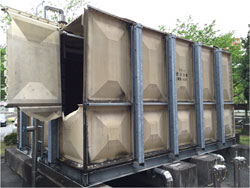
With memories of the Great East Japan Earthquake still fresh in our minds, the area in and around Kumamoto Prefecture was struck with two intensity 7 earthquakes, two intensity 6+ earthquakes, and more than 1,200 aftershocks in a little over three weeks. These earthquakes occurred directly below an active fault, with shallow epicenters that resulted in severe surface shaking and tremendous damage. Also, because it is likely that multiple faults shifted at once, it is difficult to sort out which earthquakes were foreshocks, which were aftershocks, and which was the principal event. Experts are calling the situation “unheard of” in Japan’s modern observation history.
Turning to the issue of seismic resistance in water storage tanks, damage surveys conducted after the Great East Japan Earthquake found that water tanks designed and built in accordance with the latest standards were compromised primarily as a result of sloshing[1] and bulging[2] effects.
Many municipal water storage tanks were damaged in the Kumamoto earthquake as well. Tanks that supplied water to disaster base hospitals within Kumamoto City, for example, were rendered unusable—creating a crisis situation when patients whose lives depend on water-consuming dialysis could not receive treatment. Truly, ensuring access to water is a matter of life and death.
Firstly, let’s look more closely at just a tiny handful of examples of water storage tanks damage during the Kumamoto earthquake. Then, I will also introduce the Namihei-san Tank Saver® Floating Wave Motion Suppressor, a device that was developed in order to improve the seismic performance of existing water tanks and protect our life-giving water supply when an earthquake strikes. The device was also made to be highly workable, economical, and sanitary.
2. Survey of water tank damage following the Kumamoto earthquake (focus on disaster base hospitals)
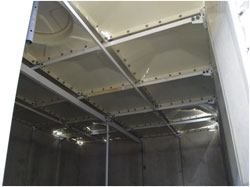
Photo 1. FRP tank at Hospital A (Minami-ku, Kumamoto City), taken April 18
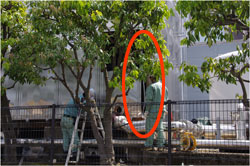
Photo 2. Stainless steel panel tank at Hospital B (Minami-ku, Kumamoto City), taken April 18. Circled area shows vertical split.
Our research team did an on-site survey in and around Kumamoto City starting April 17, which was immediately after the earthquake. Our biggest priority was making sure we didn’t hinder the rescue operations taking place in the first days after the quake, even if this meant that our surveys were not as complete as we would have liked. We were able, however, to confirm the damage to water tanks supplying key base hospitals within Kumamoto City. Photo 1 shows Hospital A, located in the Minami-ku district of the city. The upper part of the sidewall and the ceiling (you can see daylight shining through) of this fiber-reinforced plastic (FRP) tank were damaged. The fact that the damage was sustained at the top indicates that sloshing was the cause. Photo 2 shows Hospital B, also located in Minami-ku. This tank is made from stainless steel panels. Here, the lower part of the corner joint connecting the sidewalls split vertically. This type of damage is a result of the bulging effect.
We also investigated damage to an FRP tank at Medical Center C in the Chuo-ku area of Kumamoto City as well as to a stainless steel paneled tank at Hospital D in the nearby city of Koshi. Although the results of this survey were limited, there were doubtlessly many other examples of damaged water storage tanks in the area.
As a side note, the Japan Meteorological Agency has been releasing provisional long-period ground motion intensity scale ratings since 2013. The April 14 earthquake was assigned a rating of 3, while the April 15 (12:03 AM) and April 16 earthquakes were given a rating of 4. This is the first time these ratings have been given for a domestic earthquake since trial observations for long-period ground motion started, and the Kumamoto disaster registered at least three such quakes. It is likely that the long-period ground motion is what triggered the sloshing and other phenomena that ended up damaging the water storage tanks in the area.
3. Protecting our life-giving water supply during earthquakes
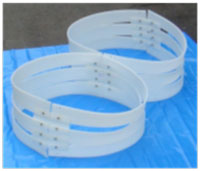
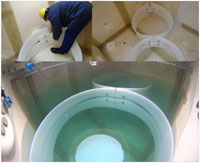
Photo 3. Namihei-san Tank Saver® Floating Wave Motion Suppressor (photo of the entire unit, scene before and after tank installation)
Studies done following the Great East Japan Earthquake revealed that sloshing, bulging, and similar phenomena damaged water storage tanks designed and built to the latest specifications. In response, we began developing a damping device that would improve the seismic resistance of existing water tanks while achieving superior workability, economic efficiency, and sanitation. This was a collaborative research project involving academia and different industries. It primarily took place at Chuo University and was carried out in conjunction with materials manufacturer Togawa Rubber, Co., Ltd. as well as the tank manufacturer NYK Co., Ltd.
Efforts to improve the seismic performance of existing water storage tanks have been ongoing for some time, but this has primarily taken the form of reinforcing exterior panels, which often ends up involving large-scale structural work. Our research is much simpler—and involves only floating panels shaped like the number eight inside the tanks. These panels are shown in photo 3. Using several different vibration tests and computational fluid dynamic analyses, we demonstrated seismic resistance could be improved by installing the assembly-type Namihei-san Tank Saver® Floating Wave Motion Suppressor for water storage tanks. The damping effect is created when resistance is generated as fluid passes through the slits in the damping device, increasing the apparent viscosity of the water. The resulting attenuation suppresses flow velocity and reduces wave height. The latest research results indicate that the suppressor is able to reduce wave height by as much as two thirds while halving the load placed on the tank during an earthquake. In addition, the device is suited for use in cylindrical tanks or large distribution reservoirs as well as in rectangular water supply tanks. Finally, the device is known to be effective against the bulging phenomenon, which is not taken into consideration under current water storage tank design standards.
The Namihei-san Tank Saver® was first installed at Yokosuka City Hospital in August 2014, and since then has been put to work at more than fifty institutions across Japan, including other hospitals, long-term care facilities, high-rise condos, and more.
4. Conclusion
Given the damage done to water storage tanks in Kumamoto earthquakes, we can assume that tanks like these will be damaged every time a major earthquake strikes . This makes it absolutely imperative that we improve their seismic capacity and prepare them for “the big one” predicted to emerge from the Nankai Trough. By installing water storage tanks with a damping device that prevents sloshing and bulging effects, we can help mitigate the effects of natural disasters and protect our life-giving water sources.
Finally, I would like to note that our research project is receiving financial assistance from a Kakenhi grant (Grant-in-aid for Scientific Research B) from the Japan Society for the Promotion of Science, as well as through the Japan Science and Technology Agency’s Adaptable and Seamless Technology Transfer Program through Target-driven R&D (A-STEP). We also have a joint academic-industrial patent pending for our results, which will be held by Chuo University. We have already secured a registered trademark for the Namihei-san Tank Saver name.
- ^Sloshing is the oscillation of fluid within a container due to relatively long-period vibrations generated outside that container. Significant oscillation results when the natural frequency of the liquid matches the vibration of an earthquake. This oscillation causes the liquid to overflow from its container and/or damage the lid or upper portion of the structure.
- ^Bulging is the coupled oscillation of a fluid and a structure that occurs when a side panel vibrates in contact with the fluid. The phenomenon involves the generation of vibration with the deformation of side panels (which act as elastic bodies). Bulging causes damage to the lower portion of containers, particularly corners.
-
Hirokazu Hirano
Professor, Faculty of Policy Studies, Chuo University
Areas of Specialization: Structural Engineering, Seismic Engineering, and Environmental Simulation - Professor Hirano was born in Tokyo in 1955. He graduated from the Department of Civil Engineering (currently the Department of Civil and Environmental Engineering) of the Faculty of Science and Engineering, Chuo University in 1979. After completing the Master’s Program of the Chuo University Graduate School of Science and Engineering with a major in civil engineering, he joined Mitsui Engineering & Shipbuilding Co., Ltd. He worked as a Part-Time Lecturer at the Chuo University Faculty of Science and Engineering and as a Full-time Lecturer/Associate Professor at the Faculty of Policy Studies before assuming the current position of Chuo University Professor in 1998. He holds a PhD in engineering. Professor Hirano conducts experiments and numerical analyses to study the prevention of swaying in structures due to factors such as wind and earthquakes. In addition to authoring research theses, he has developed various types of vibration control devices that use simple mechanisms for preventing swaying. Such devices are used at companies such as Metropolitan Expressway Company Limited, and he received his first royalties from his patent at Chuo University.
- Research Activities as a Member of Research Fellowship for Young Scientists (DC1), Japan Society for the Promotion of Science (JSPS) Shuma Tsurumi
- Important Factors for Innovation in Payment Services Nobuhiko Sugiura
- Beyond the Concepts of Fellow Citizens and Foreigners— To Achieve SDGs Goal 10 “Reduce Inequality Within and Among Countries” Rika Lee
- Diary of Struggles in Cambodia Fumie Fukuoka
- How Can We Measure Learning Ability?
—Analysis of a Competency Self-Assessment Questionnaire— Yu Saito / Yoko Neha - The Making of the Movie Kirakira Megane









